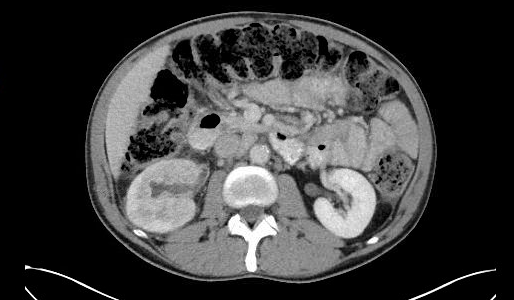Case Presentation: A 37-year-old Caucasian male with a history of uncontrolled diabetes and tobacco abuse presented with right flank pain, hematuria, and pyuria. He had several days of fever with temperature of 38.8 upon initial evaluation and white blood cell count was 19.2. His urinalysis had more than 100 white blood cells, more than 100 red blood cells, large amount of blood, negative nitrites, and negative leukocyte esterase. A renal ultrasound showed echogenic right kidney parenchyma with echogenic debris in the collecting system and proximal ureter. His blood and urine cultures were negative. He was treated with intravenous antibiotics for pyelonephritis with improvement after 48 hours, and was discharged home with oral antibiotics.
Patient had a similar presentation within the next month. Urinalysis had more than 100 white blood cells, more than 100 red blood cells, large amount of blood, positive nitrites, and large leukocyte esterase. Blood and urine cultures were negative. He was treated for pyelonephritis with a 10-day course of intravenous antibiotics.
His symptoms returned again within one week. Computed tomography scan of the abdomen and pelvis showed right-sided hydrouerteronephrosis with urothelial enhancement and thickening concerning for ascending infection and pyelonephritis (Figure 1).
Urology performed a cystoureteroscopy that showed evidence of fibrinous exudate growing in the renal calyces. Branching mold forms were seen on biopsy and culture identified Zygomycete. Infectious disease was consulted who recommended a right nephrectomy performed by Urology for source control with systemic antifungal treatment with intravenous liposomal Amphotericin B followed by transition to oral Posaconazole before discharge home.
Discussion: Zygomycosis (or mucormycosis) commonly presents in patients with diabetes, or who are immuncompromised, as an infection involving the sinuses that can spread into the bones and cerebrum. Other sites of infection include the pulmonary system, the gastrointestinal system, the skin and soft tissue, and the kidneys.
Isolated involvement of the kidney is rare. The diagnosis should be considered in the clinical context of poorly controlled diabetes along with the clinical features of fever, flank pain, gross hematuria, and pyuria. It is important to identify the organism in tissue by histopathology with culture confirmation. It is common that culture may often yield no growth.
Treatment usually requires prompt surgical involvement followed by systemic antifungal therapy. Initial therapy with liposomal Amphotericin B at a starting dose of 5 mg/kg daily is recommended for several weeks. Posaconazole or isavuconazole can be used to transition to an oral therapy once patient has improved. The duration of therapy is not clearly defined and should be individualized based upon the presentation, resolution of symptoms, and radiographic evidence of disease.
Conclusions: When evaluating and treating recurrent or resistant urinary tract infections in diabetics or immunocompromised patients with negative cultural growth, consider a fungal etiology. Infections involving Zygomycosis usually require aggressive source control with prompt surgical involvement followed by a course of systemic antifungal therapy.

